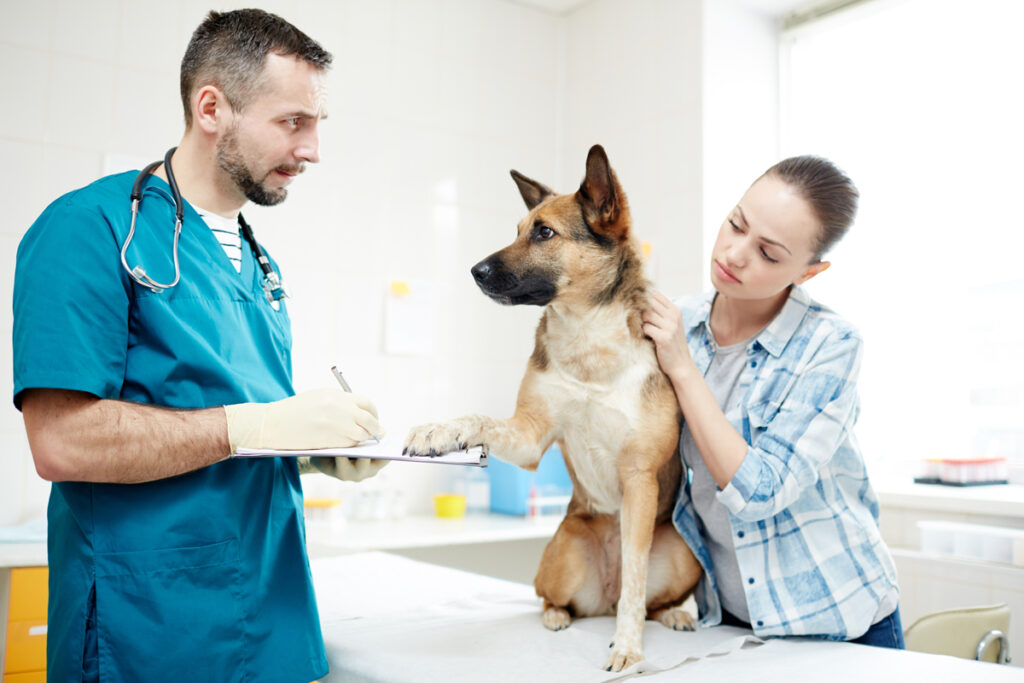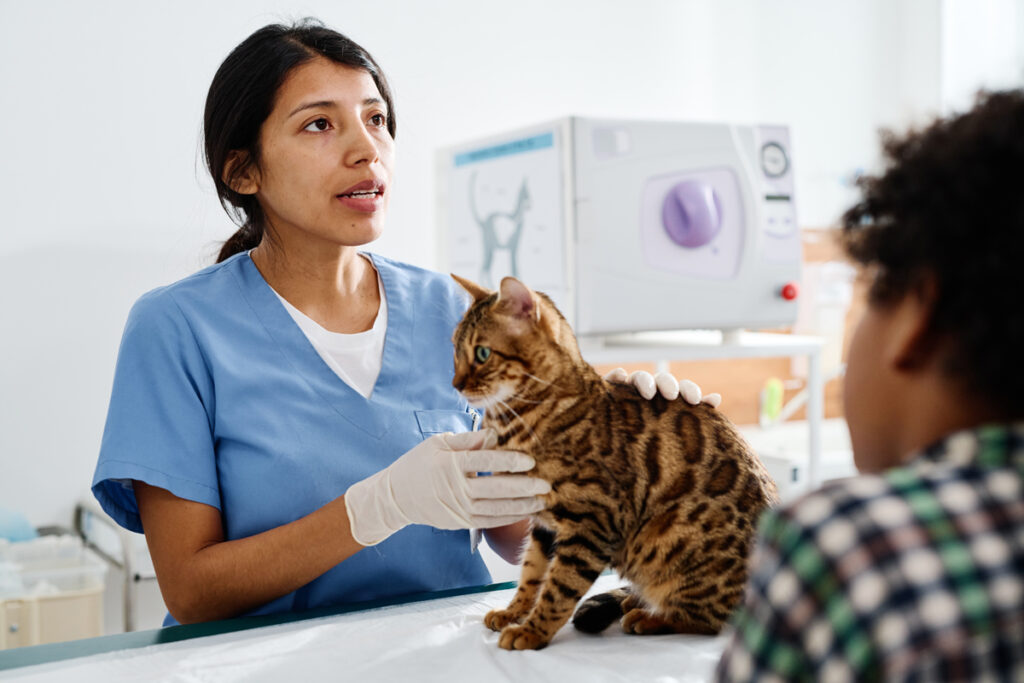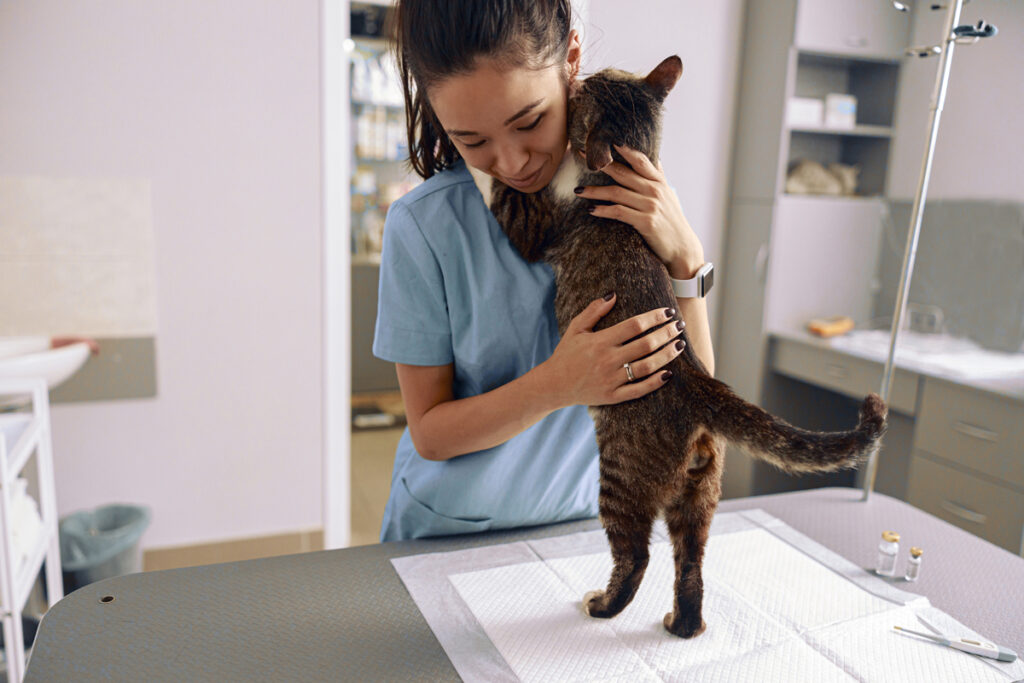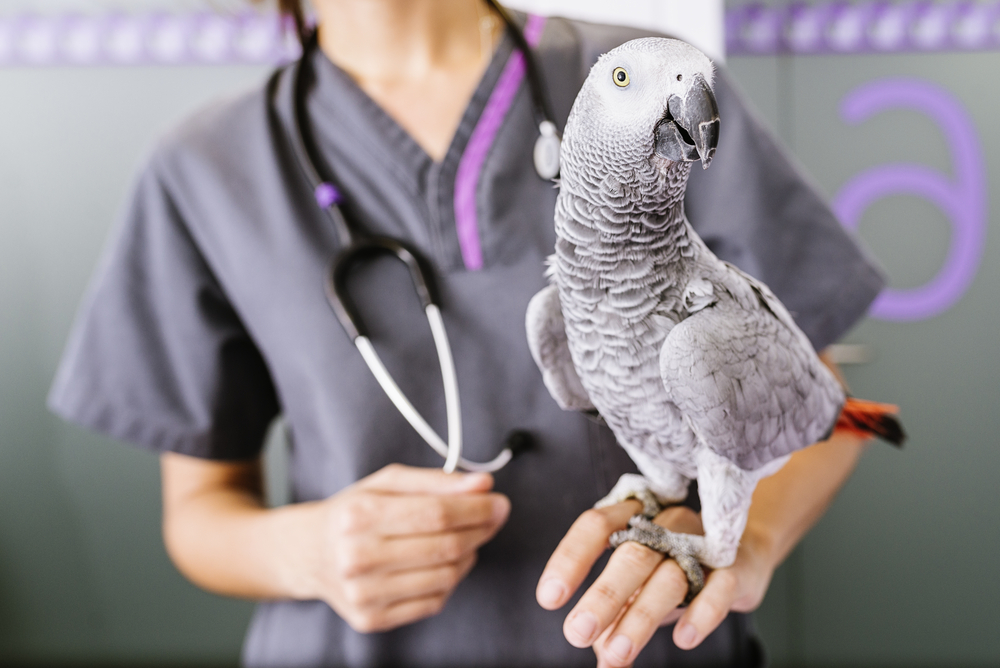
By Julie Liu, DVM
Despite our best efforts and education, we may encounter client barriers with providing Fear Free care such as refusal of PVPs or sedation, objections to safety tools like basket muzzles, and declining referral to a positive trainer to help with vet visits. It’s worth exploring other ways to help lower FAS such as regular happy visits, outdoor exam rooms, and calming supplements. However, these options are often insufficient for staff members to handle a high FAS pet safely and compassionately.
Emphasizing the safety component can help get some of these clients on board. Just as with other signs of FAS, we should educate clients when their pet is growling, hissing, snapping, swatting, baring their teeth, or showing whale eye. Some high FAS pets are in such a state of panic and “flight” that they bruise, scratch, and otherwise injure staff members when trying to get away. Clients should be informed that staff safety is non-negotiable (“We need to keep our team members safe”), and that because their pet is showing the highest level of stress possible, we are unable to proceed safely without a change in the plan. The client-facing FAS spectrum handouts for cats17 and dogs18 help illustrate these body language cues in a non-judgmental way. We should think as well about the safety of the pet as they could easily come to harm themselves. I had one high FAS canine patient who became so stressed at one visit that she had a seizure the second she walked through the clinic door, and have seen multiple dogs rub their noses raw or bite frantically at kennel bars after being dropped off.
Unfortunately, team safety, emotional health, and all of the myriad reasons to take a Fear Free approach may not be enough to convince some clients. The thought of giving their high FAS pet an anxiolytic or briefly placing a basket muzzle may be so antithetical to a client’s personal beliefs as a pet parent that they will not be swayed regardless of how many options you present.
At this point you need to ask yourself: What will be the emotional toll on me, my team, and my patient if I continue? Is it worth placing myself and my team at risk of injury? How will my decision affect Fear Free clinic culture? These are especially important questions to consider if you’re a hospital leader. Staff members may not feel comfortable voicing their ethical concerns, and leaders must always advocate for the wellbeing of their team. In 2018, the Journal of Veterinary Internal Medicine surveyed nearly 900 North American veterinarians regarding ethical conflict and moral distress19. When respondents were asked, “How often have you had a conflict of opinion with pet owners about how they wish to proceed in the treatment of pets?”, roughly 53 percent noted “sometimes,” 32 percent replied “often,” and 1 percent answered “always.” In the same survey, over 73 percent of vets responded that “not being able to do the right thing for a patient caused their staff moderate to severe stress” and 78 percent responded that this caused moderate to severe distress in themselves.
In many cases, it will be best for your team to set a boundary and either decline to continue with the visit, or even initiate a respectful conversation about why your clinic may not be the best fit. Boundaries can be scary because many of us in vet med are people pleasers20, and we feel guilty or “bad” for saying no to a client. However, boundaries are essential for protecting the emotional and physical welfare of every member of the team. When it comes to setting a Fear Free boundary, it’s also an animal welfare issue. We shouldn’t feel guilty for refusing to perform surgery on a pet when a client is against pain medications; adequate analgesia is the surgical standard of care. Similarly, we shouldn’t feel guilty for stopping with a high FAS pet when a client doesn’t respect team member safety or value their pet’s emotional health, because Fear Free is the emotional standard of care. Cultivating and retaining clients who are invested in their pet’s emotional needs will help the pet, the client, and the team succeed.
Summary
Vet clinics are often highly stressful places for pets, making high FAS pets common. Focusing on client education, being flexible during the visit, and knowing when to draw an ethical boundary will help team members navigate a safe and humane approach to the patient while keeping their own wellbeing at the forefront.
This article was reviewed/edited by board-certified veterinary behaviorist Dr. Kenneth Martin and/or veterinary technician specialist in behavior Debbie Martin, LVT.
Dr Julie Liu is a Fear Free and Cat Friendly veterinarian, speaker, and freelancer based in Austin. She serves as the Vice President of the Relief Veterinary Medical Association and recently launched My Family Cat, an in-home and virtual feline behavior consulting practice serving the cats of Austin. Learn more about Dr. Liu and her work at www.fluxvet.com and www.myfamilycat.com.
Continue learning about managing patients with high FAS through Part One, Part Two & Part Three of this series.
Want to learn more about Fear Free? Sign up for our newsletter to stay in the loop on upcoming events, specials, courses, and more by clicking here.
Resources
- Moral stress the top trigger in veterinarians’ compassion fatigue | American Veterinary Medical Association
- https://journals.sagepub.com/doi/full/10.1177/1098612X221128760
- https://fearfreepets.com/pain-and-fear-two-sides-of-the-same-coin/
- https://icatcare.org/our-campaigns/pledge-to-go-scruff-free/
- https://fearfreepets.com/treat-ladder/
- https://fearfreepets.com/top-10-treats/
- https://fearfreepets.com/wp-content/uploads/delightful-downloads/2019/01/Keep-Calm-and-Muzzle-On-1.pdf
- https://fearfreepets.com/courses/fear-free-certification-program/
- https://fearfreepets.com/courses/fear-free-certification-level-3/
- https://fearfreepets.com/fas-spectrum/
- https://fearfreepets.com/wp-content/uploads/delightful-downloads/2020/08/Dog-Sedation-Pain-Algorithm-2020.pdf
- https://fearfreepets.com/wp-content/uploads/delightful-downloads/2020/08/Cat-Sedation-Pain-Algorithm-2020.pdf
- https://fearfreepets.com/calming-pet-owners-concerns-sedation/
- https://www.felinegrimacescale.com/
- https://fearfreepets.com/courses/fear-free-level-2/
- https://www.avma.org/resources-tools/practice-management/communicating-clients-using-right-language-improve-care
- https://fearfreepets.com/resources/fear-free-store/fear-anxiety-and-stress-spectrum-cat/
- https://fearfreepets.com/resources/fear-free-store/fear-anxiety-and-stress-spectrum-dog/
- Moses L, Malowney MJ, Wesley Boyd J. Ethical conflict and moral distress in veterinary practice: A survey of North American veterinarians. J Vet Intern Med. 2018 Nov;32(6):2115-2122.
- https://www.youtube.com/watch?v=ExaL-pp9Kok&t=1531s




